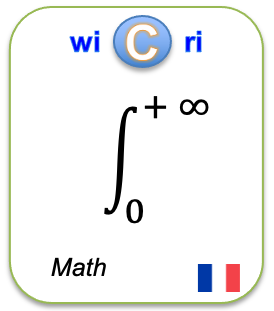Unified Theory: Fundamentals
Identifieur interne : 000243 ( Main/Curation ); précédent : 000242; suivant : 000244Unified Theory: Fundamentals
Auteurs : Gianfranco Cariolaro [Italie]Source :
Abstract
Abstract: The Unified Theory is based on two mathematical fundamentals: Abelian groups and the Haar integral. Abelian groups, developed in this chapter, will serve as the domains of signals, Fourier transforms and of their periodicity. The main problem is the identification of groups on where the Haar integral can be defined. Topology provides a clear answer to this problem: the groups must be locally compact Abelian (LCA). Another problem is the explicit formulation of these groups and of their operations. This is achieved through the technique of basis signature representation, where the basis identifies the geometry of the group and the signature specifies its nature (continuous, discrete or mixed). The main topic of the chapter is the formulation and illustration of LCA groups, both one-dimensional and multidimensional. Another important topic developed is that of cells which are subsets of a group with specific properties and represent a fundamental tool for an advanced Signal Theory.
Url:
DOI: 10.1007/978-0-85729-464-7_3
Links toward previous steps (curation, corpus...)
- to stream Istex, to step Corpus: Pour aller vers cette notice dans l'étape Curation :002977
- to stream Istex, to step Curation: Pour aller vers cette notice dans l'étape Curation :002977
- to stream Istex, to step Checkpoint: Pour aller vers cette notice dans l'étape Curation :000204
- to stream Main, to step Merge: Pour aller vers cette notice dans l'étape Curation :000243
Links to Exploration step
ISTEX:CB6559E9DA9FD11A5FE94CBAE738EB3390FF037CLe document en format XML
<record><TEI wicri:istexFullTextTei="biblStruct"><teiHeader><fileDesc><titleStmt><title xml:lang="en">Unified Theory: Fundamentals</title><author><name sortKey="Cariolaro, Gianfranco" sort="Cariolaro, Gianfranco" uniqKey="Cariolaro G" first="Gianfranco" last="Cariolaro">Gianfranco Cariolaro</name></author></titleStmt><publicationStmt><idno type="wicri:source">ISTEX</idno><idno type="RBID">ISTEX:CB6559E9DA9FD11A5FE94CBAE738EB3390FF037C</idno><date when="2011" year="2011">2011</date><idno type="doi">10.1007/978-0-85729-464-7_3</idno><idno type="url">https://api.istex.fr/document/CB6559E9DA9FD11A5FE94CBAE738EB3390FF037C/fulltext/pdf</idno><idno type="wicri:Area/Istex/Corpus">002977</idno><idno type="wicri:explorRef" wicri:stream="Istex" wicri:step="Corpus" wicri:corpus="ISTEX">002977</idno><idno type="wicri:Area/Istex/Curation">002977</idno><idno type="wicri:Area/Istex/Checkpoint">000204</idno><idno type="wicri:explorRef" wicri:stream="Istex" wicri:step="Checkpoint">000204</idno><idno type="wicri:Area/Main/Merge">000243</idno><idno type="wicri:Area/Main/Curation">000243</idno></publicationStmt><sourceDesc><biblStruct><analytic><title level="a" type="main" xml:lang="en">Unified Theory: Fundamentals</title><author><name sortKey="Cariolaro, Gianfranco" sort="Cariolaro, Gianfranco" uniqKey="Cariolaro G" first="Gianfranco" last="Cariolaro">Gianfranco Cariolaro</name><affiliation wicri:level="1"><country xml:lang="fr">Italie</country><wicri:regionArea>University of Padova, Padova</wicri:regionArea><wicri:noRegion>Padova</wicri:noRegion></affiliation><affiliation wicri:level="1"><country wicri:rule="url">Italie</country></affiliation></author></analytic><monogr></monogr></biblStruct></sourceDesc></fileDesc><profileDesc><textClass></textClass><langUsage><language ident="en">en</language></langUsage></profileDesc></teiHeader><front><div type="abstract" xml:lang="en">Abstract: The Unified Theory is based on two mathematical fundamentals: Abelian groups and the Haar integral. Abelian groups, developed in this chapter, will serve as the domains of signals, Fourier transforms and of their periodicity. The main problem is the identification of groups on where the Haar integral can be defined. Topology provides a clear answer to this problem: the groups must be locally compact Abelian (LCA). Another problem is the explicit formulation of these groups and of their operations. This is achieved through the technique of basis signature representation, where the basis identifies the geometry of the group and the signature specifies its nature (continuous, discrete or mixed). The main topic of the chapter is the formulation and illustration of LCA groups, both one-dimensional and multidimensional. Another important topic developed is that of cells which are subsets of a group with specific properties and represent a fundamental tool for an advanced Signal Theory.</div></front></TEI></record>Pour manipuler ce document sous Unix (Dilib)
EXPLOR_STEP=$WICRI_ROOT/Wicri/Mathematiques/explor/BourbakiV1/Data/Main/Curation
HfdSelect -h $EXPLOR_STEP/biblio.hfd -nk 000243 | SxmlIndent | more
Ou
HfdSelect -h $EXPLOR_AREA/Data/Main/Curation/biblio.hfd -nk 000243 | SxmlIndent | more
Pour mettre un lien sur cette page dans le réseau Wicri
{{Explor lien
|wiki= Wicri/Mathematiques
|area= BourbakiV1
|flux= Main
|étape= Curation
|type= RBID
|clé= ISTEX:CB6559E9DA9FD11A5FE94CBAE738EB3390FF037C
|texte= Unified Theory: Fundamentals
}}
|
| This area was generated with Dilib version V0.6.33. | |



